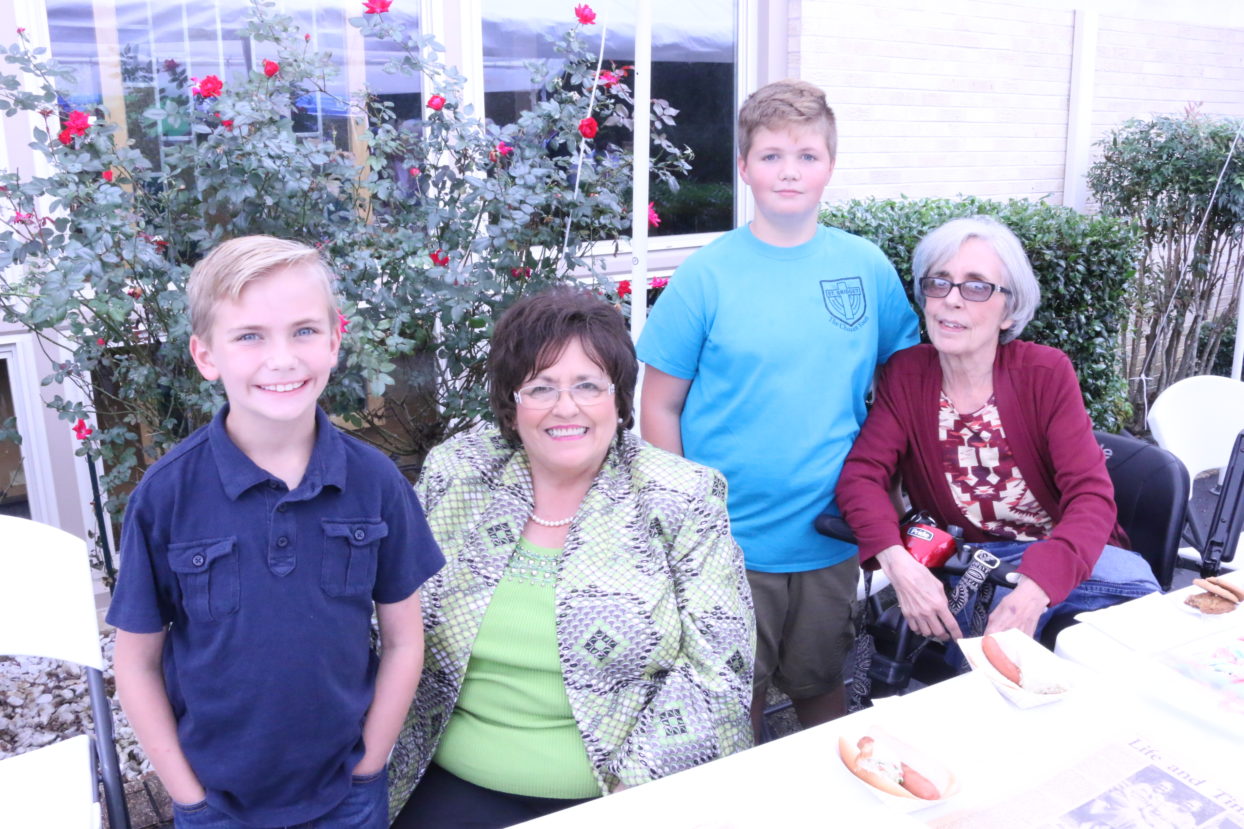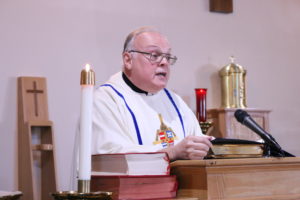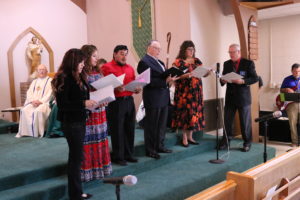The parish’s church building turns a half-century old as nearly 400 join Bishop Stika at Mass
By Dan McWilliams
St. Bridget Parish in Dayton on Oct. 14 celebrated the 50th anniversary of its church building, a structure close to the heart of late Nashville Bishop and Dayton native Joseph A. Durick.
The parish, formerly known as St. Genevieve, now bears the name of the bishop’s mother, Bridget Gallagher Durick.
Bishop Richard F. Stika presided at a bilingual Mass, attended by a full house of 385 parishioners, family, friends, and visitors. St. Bridget pastor Father Sam Sturm delivered a bilingual homily and also played piano during the liturgy. Deacon Tom Kiefer, who was ordained by Bishop Durick, came out of retirement to assist at Mass.
“Father Sam amazes me,” Bishop Stika said. “I’m getting ready to see if he also parks the cars, cleans the floors, and takes my job,” the last line followed by laughter and a round of applause. “So you’re clapping because you want him to take my job?”
The bishop then thanked the parish.
“I just want to say gracias, thank you, for being the face of Jesus, for being the hands of Jesus in acts of charity and kindness, and by your love for being the heart of Jesus,” he said. “I don’t think there’s anything else I can say, but I see it here. For 50 years this parish has been a shining light in Dayton, and even before that with the first church of St. Genevieve. I always wondered where the name St. Bridget came from. Now I know it’s from a priest who was born in Dayton and then eventually became a bishop, and he named this church after his mother. The power of a bishop.
“If I begin another parish, it’ll be St. Helen,” added the son of Frank and Helen Stika.
Father Sturm expressed his gratitude to a number of people.
“We are grateful for all of those who have selflessly given of themselves to renovate the building, installing new ceiling tiles, new LED lighting, new carpeting, and the moving of the tabernacle to the center of the sanctuary,” he said. “Also, installing that camera back there so the people in the hall can go to Mass while we’re in Mass here, and waxing the floors.”
The pastor thanked the bishop for coming.
“Deacon Tom, thank you for coming out of retirement in order to assist the bishop at this special liturgy,” he said, before recognizing his mom and two brothers in attendance.
Two sisters, Mary Katherine Hill Travis and Regina Hill Corvin, are relatives of Bishop Durick and lifelong St. Bridget parishioners.
“Bishop Durick and my mother were first cousins,” Mrs. Travis said. “He’s been to my house to eat.”
Mrs. Corvin was the first child baptized in St. Bridget Church, in 1946.
“We and our children are the last of the Gallaghers to be members here,” Mrs. Corvin said. “I’m the longest member of the church, and Mary is the second-longest. I’ve been going to this church 72 years, and she’s been going 70, our whole life.”
Being a Catholic child in Dayton in the 1940s and ’50s put one in a small group.
“My sister and I, we lived here during a period of time when there were no other children who were Catholic in this county,” Mrs. Corvin said. “My sister and I were the only two [Catholic] children in the school system from the first through the 12th grade. We were in a small Baptist town, but we survived it very well. Our church has always been our life because of our Gallagher great-grandmother and then our grandmother, and of course, her sister, Bridget, who was the mother of Bishop Durick.”
The Hill family knew Bishop Durick “very well,” Mrs. Corvin said.
“He was like an uncle to us, even though he was our second cousin, because he stayed with us often, especially during the period of time of Civil Rights,” she said. “Bishop Durick was a leader in Civil Rights as bishop of Tennessee. During that period of time, he received lots of threats. During those times that he would be threatened, he would often come here and stay and let things cool down. He spent lots of time here with us, with our mother, in her house, then his sisters would come with him and they’d all stay with us. The Gallaghers, the church was their life. The church was our mother’s life, and all of our cousins who still live in Birmingham, (Ala.), where the bishop was raised.”
The history of the Church in Dayton dates to the late 19th century. In 1888, George Jamme, superintendent of the Dayton Coal and Iron Co., obtained a plot of land from the company and was responsible for building St. Genevieve Church and School in Dayton.
St. Genevieve Academy Boarding and Day School was opened in February 1891 by Mother Cleophas of the Sisters of Charity of Nazareth in Nazareth, Ky. About 40 children were enrolled when the school opened, including Mr. Jamme’s son and daughter. The Sisters of Mercy succeeded the Sisters of Charity in operating the school in September 1895.
When the coal and iron company faced hard times, parishioners of St. Genevieve moved elsewhere for work. The school closed in 1896 and the church in 1903.
Mass was celebrated for some time in Katherine Gallagher’s home by priests who would come to town on Saturday, stay at the home, and celebrate Mass on Sunday.
“Our great-grandparents, Katherine and James Gallagher—it was their house,” Mrs. Corvin said.
Stephen Durick, father of the bishop, purchased a two-story house on East Second Avenue in 1941 and donated it in memory of his wife, Bridget, who had died in 1939, to the Catholic families of Dayton for use as a chapel.
“When it first became St. Bridget they opened it in 1941 on what we called Washington Street back then,” Mrs. Travis said.
The chapel served the community well until 1966, when an industrial-rejuvenation project caused the Catholic population of Dayton to grow rapidly.

Bishop Richard F. Stika draws a laugh from Deacon Kiefer and the assembly at St. Bridget. “For 50 years this parish has been a shining light in Dayton,” the bishop said during his remarks at Mass.
In 1966, Father Francis Pack became pastor of St. Bridget Chapel and was given the task of supervising the building of a new church. The chapel was becoming crowded at Mass, even more so with summertime visitors. In September 1967, the parish learned that Bishop Durick approved a credit of $20,000 from the Diocesan Development Fund as a gift for the new church in Dayton and sent a check for $4,500 for the purchase of a plot of ground on Walnut Grove Road.
Ground was broken May 19, 1968, following Sunday Mass in the chapel with Father Pack. Katharine Hill tossed the first spadeful of dirt. On Dec. 22, 1968, Bishop Durick, who died in 1994 celebrated the first Mass in the new church. Father Pack and Father Joseph Breen concelebrated.
For the formal dedication of the church the following May 11, Bishop Durick was joined in the celebration of the Mass by Father Pack, Father Breen, Father L.A. Maxwell, and Father John McMurray. Clergy of other denominations attended, as did the bishop’s brother and four sisters.
“My daughter, Katherine Whitaker, was the first person of the original family to marry in this church,” Mrs. Corvin said.
From seven families in 1961 to 80 in the early 1990s, St. Bridget has grown to about 350 families today.
Parish photographer Virginia Bishop has been a parishioner of St. Bridget for 23 years.
What does St. Bridget mean to her?
“My social center,” she said.
“Anything that you need, you can get through the social center here. They’re very wonderful people.”
The church has grown considerably in her years there, Mrs. Bishop said.
“Yes, indeed, it has. It has grown a great deal. I must say I’ve been impressed; it hasn’t changed its ways. It’s amazing how much they can fundraise. The people are so generous. I’m impressed with them. They’re still very generous. They’re still very open.”
She’ll never forget her first Mass at St. Bridget.
“I came to Mass out of the blue,” Mrs. Bishop said. “I’d moved in the day before, and I came to Mass, and I just walked in, and one of the ladies got up out of the pew, and she came over to me and she said, ‘Welcome to St. Bridget’s.’ That was within the first five minutes of my first visit. Can you get better than that?”
That’s a far cry from her church experience on Long Island, N.Y.
“My experience with the church was much different there because it was grandiose—much, much larger— and much more difficult for you to become involved in particular intimacy, so I think that’s why it impresses me here,” she said.
Victoria Welch of St. Bridget went to the church when it was in the house in downtown Dayton.
“The house itself was very, very small,” she said. “They were lined up along the sidewalk in the summertime with all the tourists. It was just so different, coming from Illinois. But it was great, and it was great to get the nice, new big church built. This is fantastic, the 50th anniversary here.”
The parish has “definitely” grown in her time as a parishioner, she said.
“It has definitely, through the industries that brought a lot of northerners down, Catholics, and it’s just been great.”
Mrs. Corvin spoke of her religious-education experiences as a youth in Dayton.
“We had to travel to Blessed Sacrament in Harriman for our Catholic catechism education, where the nuns taught us every summer,” she said. “We would commute daily for probably two or three weeks a year or maybe longer. That was a long haul for children. We were just in grammar school. Our parents hired a driver to drive us there back and forth every day so that we could be educated in the catechism and receive our sacraments.”




